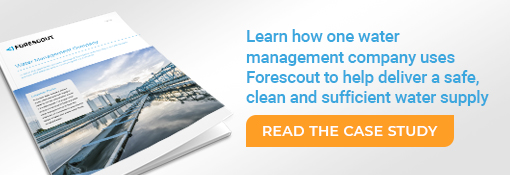5 Questions to Answer to Improve Cybersecurity in Water and Wastewater Management
In the 21st century, water and wastewater management companies, much like electric utilities, have become more dependent on IP-connected devices to operate efficiently. Water and wastewater utilities rely on many of the same equipment providers as electric power companies, and are therefore subject to similar cyberthreats. Because of this, many water and wastewater utilities are under increased scrutiny.
Some of the challenges faced by water and wastewater management today include:
- More stringent cybersecurity standards and regulations, like America’s Water Infrastructure Act of 2018.
- Increased automation and connectivity in industrial control systems (ICS), leaving them more vulnerable than ever to cyber and operational threats.
- Heightened geo-political tensions and recent cyber espionage from state-sponsored malicious actors, potentially leading to an uptick in cyberattacks and intrusion attempts.
5 Questions Water and Wastewater Companies Must Answer
Water management companies must ensure that every part of their daily operations is closely monitored, since failures at one point create a domino effect, potentially endangering the water supply. Only safe infrastructure can provide clean, healthy water – so it’s really important to know the answer to these questions:
- What are our assets and where do they sit on the network?
- Which ones are controlled manually, and which ones are automated?
- Which assets are connected to the internet and can be controlled remotely?
- Where do the vulnerabilities in the system lie?
- How could a malicious actor use these vulnerabilities to enter and disrupt operations?
Cybersecurity standards for water and wastewater companies are also getting stricter. To comply, ICS networks must be continuously monitored and undergo periodic risk assessments to stay on top of their cybersecurity game.
What Should Water and Wastewater Companies Do Now?
To answer these 5 questions, water and wastewater companies can deploy a comprehensive OT network monitoring solution. By automatically creating and monitoring an asset inventory, these tools not only answer the questions above, but also help streamline compliance with regulatory standards. Some of the benefits of network monitoring include:
- Reduced asset inventory costs by automating the process of creating and maintaining one.
- Reduced workload for both cybersecurity and operations teams.
- Improved overall security of operations, especially if combined with network segmentation efforts.
These solutions can also analyze the flow of changes to the system to help ensure alignment with required regulatory documentation. The data captured by them can also help with implementing network policies to prevent unauthorized and/or dangerous behaviors, monitoring the system for scheduled and unscheduled maintenance, validating operational processes, and controlling policy execution.
To learn more about how one national water management company answered these questions and streamlined their regulatory compliance efforts by implementing OT network monitoring, read this case study.
